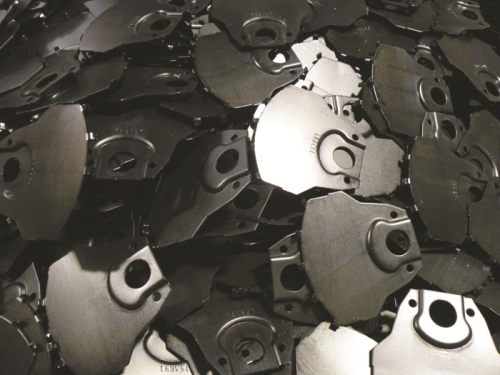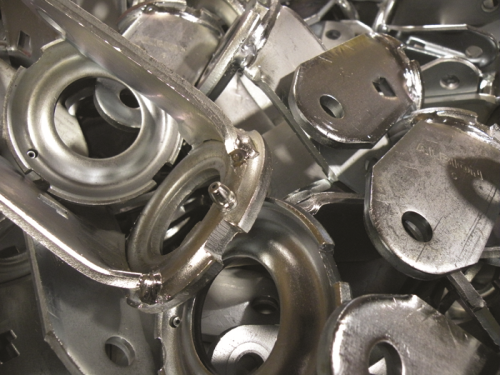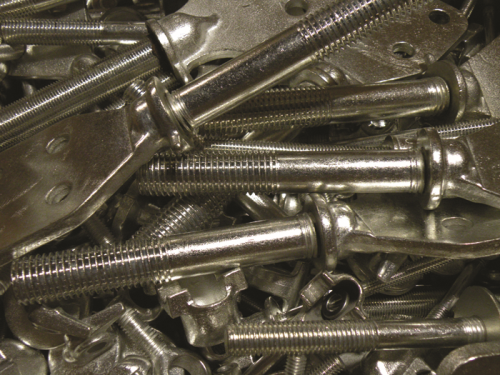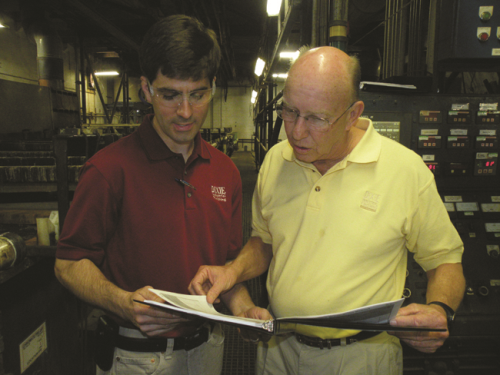



If you can’t measure it, then you can’t manage it.” That’s the driving philosophy espoused by the folks at Dixie Industrial Finishing, the Tucker, Ga.–based surface finishing operation whose dedication to finish quality and technological innovation is rivaled only by its relentless focus on operational management and maximizing productivity. Informally referred to by the more palatable acronym (“DIFCO”), the 51-year-old Dixie Industrial Finishing Company has a long-standing reputation as one of the largest finishers in the Southeast U.S. Specializing in zinc plating/electro-galvanizing, phosphate coating, and tin plating—among other processes—DIFCO’s combination of large part-size capacity tanks and reliably automated computer controls facilitates the production of higher volumes in a shorter time than “most metal finishing facilities in North America,” the company boasts. All this at competitive price points not only regionally but globally as well. But this is not a tale of grandeur and scale. (Although, at 175,000 total sq. ft. DIFCO clearly holds its own.) Rather, it’s a study in the uncompromising level of detailed operational analysis that goes into virtually every aspect of Dixie’s business. From incorporating just the right mix of chemicals/additives in the bath make-up, to the utilization of water for rinsing vs. other applications, to the impact of line speed, etc., each and every activity, process, system, and asset is measured and tweaked accordingly. This ensures the plant is functioning at optimum efficiency from a manufacturing standpoint but also cost-effectively in terms of dollars allocated to materials, personnel, handling, and maintenance. “We scrutinize every aspect of these machines,” said Jim Jones, DIFCO’s vice president. This is made possible, he says, via sophisticated software and programs employed in generating the various metrics. (Visual Shop1 and other information processing systems together allow the data collection. Visual Shop provides primarily tracking information related to customers’ parts, while other systems generate additional operational and financial information.) All of these systems together feed into a real-time, activity-based cost accounting report system that compiles routine data on usage of labor and raw materials in production terms (per machine cycle, per amp hour, per sq. ft); generates daily production reports, i.e., surface area covered vs. lbs of parts finished; tracks all inputs and outputs; and sends reports to key departments and vendors. These seemingly endless reams of information routinely rolled out by the systems DIFCO employs is simply mind-blowing. Via the sophisticated software and measurements utilized, managers and supervisors can isolate a host of variables, including: chemical and anode usage per machine; direct labor costs per machine cycle; maintenance and technical services time allocation; water consumption by specific piece of equipment; and electricity and gas costs per process line. What’s more, DIFCO can run scenarios to see how a potential new job might impact the bottom line, changing variables such as price, volume, and which process line to utilize, etc. The various metrics can then be further represented as a percentage of sales dollar. All this allows DIFCO—originally ISO-certified in 2002—to estimate profitability, study performance and efficiencies, manage costs, and even catch problems quickly. The minutiae of the reporting is a bit much to take in at first, but when you realize the bottom-line impact on the business, it all seems well worth the investment in time, resources, and money. “Tracking the measurables allows us to set goals and cascade them down to all levels of the organization,” said Chris Henderson, DIFCO’s information manager. “We closely analyze operations, allocate labor, and structure shifts accordingly. We’re always looking at the various facets of the operation and asking the question, ‘Why?’ ” A classic example of the tangible results DIFCO achieves through its ongoing self-examination is the ongoing reduction in water usage. Between 2007 and 2008 DIFCO reduced water consumption by 39%. Another eye-opening statistic: In 1998, the company used 36 million gallons of water in operating its process lines for an average of 5 gallons of water per sales dollar; by 2010, consumption had been reduced to 5.2 million gallons for an average of 0.88 gallons of water per sales dollar. Additional savings are achieved by reusing water in non-critical rinse applications. Again, according to Henderson, it all goes back to the core metrics. “We constantly monitor usage to make sure we use just the right amount of fresh vs. recycled water in our processes,” he explained. “This allows you to minimize waste and lower costs.” And when you’re flushing through 150,000–200,000 gallons per week across the operation, an adjustment here or there can make a big difference. DIFCO employs advanced technology and analytics to boost production efficiency in other areas of its operation as well, namely its core plating processes. This is due in large measure to the fact that the company’s in-house engineers design, fabricate, and install their own lines. Among the production gains and improvements accomplished as a consequence:
2007—Modified load-unload area of high production process (Rack #5) to accommodate flexible racking system. The combination of redesigned fixtures and racking area more than doubled productivity.
2007—Designed, constructed and installed an automated, high-volume zinc barrel plating process line, with programmable logic controls (PLC), and laser positioning for hoist operation. Boasting multiple process selections, this line—which replaced two older, less-flexible units—is capable of churning out 6,000 lbs of product per hour.
2009—Re-engineered plating racks on one process line (Rack #3) for higher piece/part population, going from 60 sq. ft. of surface area to 105 sq. ft. of surface area per cycle—a 75% productivity gain.
2000–2004—Increased capacity on its rod-plating line by 260%, allowing DIFCO to be more competitive with imports and grow its market share.
2010—Re-engineered the racking system of the rod-plating line (Rack #6) to increase productivity by 20% over and above the production increases that were implemented between 2000–2004. For DIFCO, the achievements represent much more than a list of celebratory milestones. They reflect an operational mindset that puts the emphasis on consistently high acceptance rates. “Reject reduction + cost reduction = efficiency,” declared Jones in one of his signature expressions. The end result, he says, is a reject rate of work (processed and shipped to the customer) totaling less than .001%.
|
*High-qualiy, high-volume rack & barrel processing *5 automatic lines; 4 manual process lines *Chromating of aluminum *Electro-galvanizing *Zinc and tin plating *Manganese and zinc phosphate coating *Trivalent chromating of zinc *Stainless steel passivation *Large part size capacity tanks *ISO-9001:2008 Certified |
LEAN AND GREEN On its own, DIFCO’s efficient, activity-based system serves a model operation for aligning costs with resources and output. But at closer inspection, you’ll find that there’s also a symbiotic relationship between the company’s approach to production and its overall environmental philosophy. The technological innovations DIFCO employs in its plating and finishing methods are the same advances utilized in facets of the business pertaining specifically to environmental protection and resource conservation. Case in point: During a severe drought situation back in 2007, the local governor’s office requested a “voluntary” 10% reduction in water use by commercial industries. After DIFCO reviewed its processes, it enacted a water-reduction use program that exceeded that amount by five-fold. This was accomplished in part by: using flow restrictors; programming solenoids to open only when the hoist on the equipment was operating; regulating frequency of rinse tank dumps; and modifying plumbing infrastructure. Several years prior, DIFCO installed a high-tech micro-filtration wastewater treatment system that, according to Jones, ensures the water that leaves its facilities is cleaner than what it was when it entered the plant. That “green” thought process applies to solid wastes, too. For instance, DIFCO regularly recycles cardboard, scrap steel, and containers such as totes and drums. Additionally, the company sends solid by-product (sludge cake) to an off-site location for stabilization and neutralization. Typically, Henderson notes, 70% of waste is reduced to 30% waste after drying sludge. In recognition of DIFCO’s emphasis on green, the United States Environmental Protection Agency in 2003 identified the company as the model for an international trade tour to America. As part of this event, DIFCO hosted a delegation of Vietnamese government representatives studying the management of hazardous waste generated at small and large facilities in the steel industry. The company also hosted a tour for Peru’s vice president, who is involved in manufacturing in that country. As any finisher or chemical supplier will tell you, environmental compliance comes at a premium, but for Dixie Industrial Finishing it is well worth the expense. “We made the investment so our customers would have a great sense of security and so we could sleep at night,” Jones said. “There’s also a sense of fulfillment that you’re doing the right thing.” The same can be said for the lengths DIFCO goes through to ensure the overall safety, health, and well being of its employees. In illustration, Jones recalled the story about how an inspector toured his facilities during a routine ISO audit. While Jones was eager to take the visitor straight to the plant, the inspector first asked to see some of the common areas (bathrooms, kitchen, etc.). “If you are taking care of those areas for your employees,” the inspector told Jones, “then it’s likely you are also taking care of the operational aspects of your business.” And he was right. DIFCO’s workman’s compensation modification rate was 0.84 for 2010 (and falling). It’s also worth noting that the average term of employment for all employees at Dixie Industrial Finishing is 131⁄2 years. Attributes such as these helped DIFCO earn the 2005 Manufacturer of the Year Award (Small Manufacturer Category). For those who nominated the company for the coveted honor, the justification is abundantly clear. “Dixie Industrial Finishing is recognized as a valued and respected presence in DeKalb County,” stated Dr. Robbin Hoffman, president of DeKalb Technical College. “Its customer base includes small, medium, and large manufacturers who, in turn, supply parts to large automotive manufacturers and other global companies. Many large companies use the parts plated by Dixie Industrial Finishing in the production of goods distributed throughout America. Dixie consistently proves to be a leader in corporate responsibility, economic impact, and workforce excellence.” In addition, Dr. Hoffman notes, DIFCO boasts a multi-national, multi-cultural workforce and provides company-funded English as a Second Language (ESL) classes to more than 20% of its employees. The company offers in-house computer software and keyboard training for its employees, encourages them to attend job skill seminars, and offers reimbursement for tuition expenses. “As a local business leader, Dixie is an advocate for education and sees the need for technical training provided by DeKalb Technical College,” Dr. Hoffman added. “Dixie Industrial Finishing Company genuinely cares about its workforce family and community.” Good corporate citizenship, technical wizardry, green focus, and analytical prowess aside, DIFCO’s success and continuous improvement essentially hinges on a genuine “team spirit” and the fact that all employees—from production line operators, to management, to porters—take a strong sense of pride and ownership in the company. On one end, supervisors are continually challenged to boost quality and productivity, while performance-based incentives aim to motivate and reward line workers. At the end of the day, everyone comes together to achieve a common goal: operational excellence. Jones, in another of his parabolic catch phrases, smiles and states simply: “All of us are smarter than one of us.”
For more on this story, please see the July/August 2011 edition of Metal Finishing.
REFERENCES 1. Visual Shop from Cornerstone Systems, Inc. (CSI) is a customizable software system that allows finishers to measure a variety of variables and perform different functions, including: production optimization, quality assurance, cost/benefit assessment, quotations, order invoicing and tracking, among other aspects.






